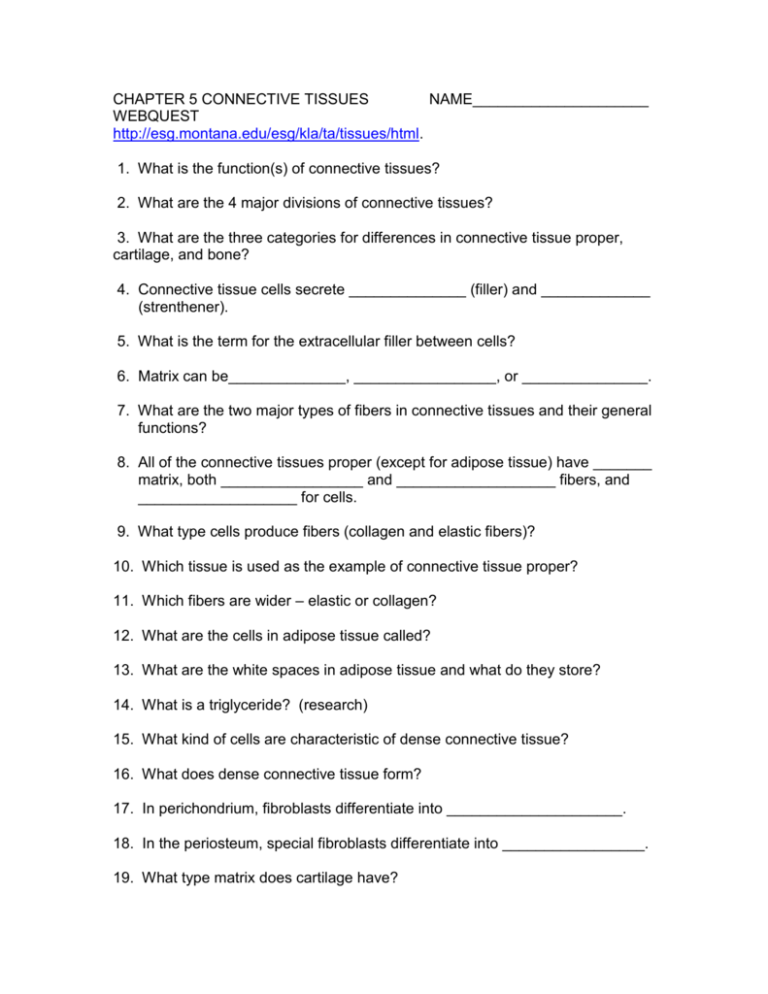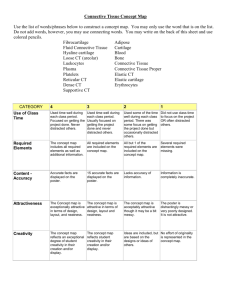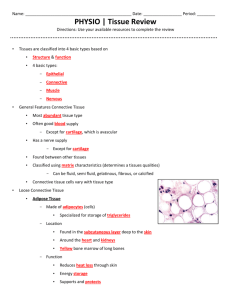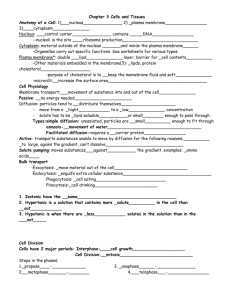CHAPTER 5 CONNECTIVE TISSUES
advertisement

CHAPTER 5 CONNECTIVE TISSUES NAME_____________________ WEBQUEST http://esg.montana.edu/esg/kla/ta/tissues/html. 1. What is the function(s) of connective tissues? 2. What are the 4 major divisions of connective tissues? 3. What are the three categories for differences in connective tissue proper, cartilage, and bone? 4. Connective tissue cells secrete ______________ (filler) and _____________ (strenthener). 5. What is the term for the extracellular filler between cells? 6. Matrix can be______________, _________________, or _______________. 7. What are the two major types of fibers in connective tissues and their general functions? 8. All of the connective tissues proper (except for adipose tissue) have _______ matrix, both _________________ and ___________________ fibers, and ___________________ for cells. 9. What type cells produce fibers (collagen and elastic fibers)? 10. Which tissue is used as the example of connective tissue proper? 11. Which fibers are wider – elastic or collagen? 12. What are the cells in adipose tissue called? 13. What are the white spaces in adipose tissue and what do they store? 14. What is a triglyceride? (research) 15. What kind of cells are characteristic of dense connective tissue? 16. What does dense connective tissue form? 17. In perichondrium, fibroblasts differentiate into _____________________. 18. In the periosteum, special fibroblasts differentiate into _________________. 19. What type matrix does cartilage have? 20. What is the difference between chondroblasts and chondrocytes? 21. What are the three types of cartilage? 22. What are the characteristics of hyaline cartilage? 23. Where is hyaline cartilage found in the body? 24. What is the term for the spaces where chondrocytes lie? 25. What are the characteristics of elastic cartilage? 26. Where is elastic cartilage found in the body? 27. What are the characteristics of fibrocartilage? 28. Where is fibrocartilage found in the body? 29. Describe the matrix an fibers present in bone (osseous) tissue. 30. Distinguish between osteoblasts and osteocytes. 31. Describe the arrangement of compact bone. 32. Describe each structure: (A) osteon or Haversian canal (B) lamellae (C) lacunae (D) canaliculi 33. What is the function of canaliculi? http://www.unomaha.edu/hpa/2740connectivetissue.html 34. What is referred to as “ground substance” in connective tissues? 35. What is the most common cell in connective tissues? 36. Where are each of the connective tissues listed below located in the body and what are its functions? (A) Areolar Connective Tissue (B) Dense Regular Connective Tissue (C) Elastic Connective Tissue (D) Reticular Connective Tissue (E) Adipose Tissue Choose Cartilage and Bone. 37. Summarize the characteristics, locations, and functions of the three types of cartilage and bone. (A) hyaline cartilage (B) elastic cartilage (C) fibrocartilage (D) bone (osseous) tissue http://www.emc.maricopa,edu/faculty/farabee/BIOBK/BioBookAnimalTS.htmlcon nective%20Tissue Choose Connective Tissue. Scroll down to information on Blood. 38. What is unique about the matrix of blood? 39. What is the liquid component of blood called? 40. What are the two types of cells in blood? (scientific names) 41. What is the name of the cell fragment that functions in blood clotting? Study the micrographs of blood. Identity the red blood cell (erythrocytes), white blood cells (leukocytes), platelets (thrombocytes), and plasma.







